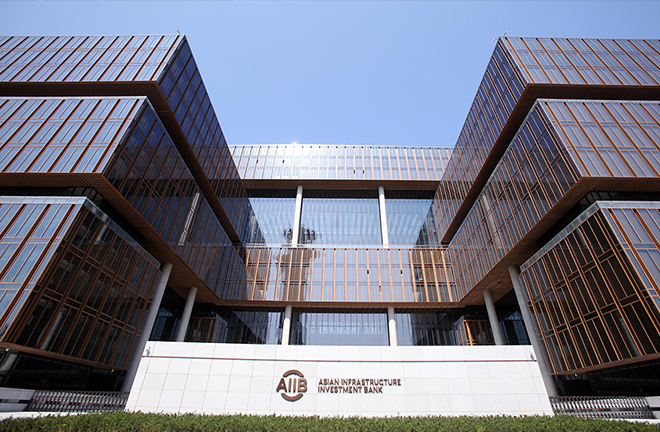Promoting B&R’s multilateral development and int’l cooperation

The Asian Infrastructure Investment Bank (AIIB) in Beijing Photo: CFP
The Belt and Road (B&R) initiative has achieved fruitful results since it was put forward in 2013. It has become the largest international cooperation platform in scale and coverage globally. By the end of 2021, China has signed more than 200 cooperation documents for the joint construction of the B&R with 145 countries and 32 international organizations. The multilateral, institutionalized, and organized development of the B&R and the enhancement of international cooperation levels should shape the B&R’s development direction.
Fostering multilateral cooperation
The B&R is a Chinese plan to deal with the three major deficits in peace, development, and governance which the international community faces. The B&R follows the principle of extensive consultation, joint contribution, and shared benefits. Its strategic goal is to establish a community of shared interests, future, and responsibilities with political mutual trust, economic integration, and cultural inclusiveness. As one of China’s positive attempts to provide international public goods, the initiative and concept of the B&R are multilateral.
At the opening ceremony of the second Belt and Road Forum for International Cooperation on April 26, 2019, President Xi Jinping pointed out that “the complementarity between the BRI and the development plans or cooperation initiatives of international and regional organizations such as the United Nations, the Association of Southeast Asian Nations, the African Union, the European Union, and the development strategies of the participating countries has been enhanced.” As such, multilateral development has become a new path of the B&R’s development.
Currently, the B&R is mainly based on a series of bilateral relations between China and B&R countries. Signing a memorandum of understanding represents the primary form of cooperation agreements, with the support of a joint statement issued by the two governments. From a legislative perspective, the binding force is weak for the two sides. Promoting the multilateral development of the B&R will enhance the transparency and binding force of B&R regulations, increase international community’s trust in the B&R, and become the key direction of the B&R’s sustainable development.
First, multilateral cooperation facilitates the institutionalization of the B&R. At present, the B&R has been in the process of institutionalization, but the degree of which is relatively low. Second, multilateral cooperation facilitates the B&R’s regulation. Strengthening cooperation with international organizations allows B&R construction to become more conversant with existing international rules, to apply them as soon as possible, and to reform and innovate international rules in the process of joint construction. Third, multilateral cooperation is conducive to integrating resources, promoting complementarity among various parties, and realizing professional development. Fourth, multilateral cooperation will facilitate the B&R’s sustainable development. The diversified financing structure can enhance the vitality and sustainability of B&R projects. Fifth, multilateral cooperation can enhance the security of the B&R. Building a transparent and equitable multilateral framework can effectively avoid many uncertainties in bilateral relations.
Promoting international collaboration
The multilateral cooperation of the B&R requires standardization, openness, and institutionalization in rule formulation, personnel composition, organization management, and project implementation. With this, the B&R can attract more countries to become actively involved, strive for more development space, and create more opportunities for the world’s economic recovery.
Firstly, the B&R organizational structure and multilateral decision-making management mechanism should be established and improved, for instance, setting up a B&R international committee and other permanent establishments, constructing a new order of B&R global governance and regional governance.
Secondly, it is advisable to increase multilateral cooperation partners under the UN’s framework, to connect the B&R with major governance institutions under our current international order. For instance, the international influence and bridging role of the UN should be fully employed, to promote dialogue among B&R countries. The B&R can be upgraded from a Chinese initiative to an international development agenda, institutionalized and organized to become a truly international cooperation platform and international public good.
Lastly, the third-party market cooperation, first initiated by China, is a “new-type” platform for the joint construction of the B&R. In recent years, China has signed 16 third-party market cooperation documents with 14 countries, including France, Japan, Italy, and the UK. The third-party market cooperation model highlights complementary advantages. It can effectively match China’s advantageous production capacity, the advanced technologies of developed countries, and the needs of developing countries, to provide a new path for high-quality B&R joint construction.
Focusing on infrastructure
Infrastructure construction is a key starting point for the world economic recovery. China’s advantages and achievements in infrastructure have attracted worldwide attention. It is relatively easy to reach a consensus on international cooperation by focusing on infrastructure construction.
The B&R can also become more inclusive by attracting more developed countries. The B&R is a public good which China provides to the world, and the whole world can participate in it and benefit from it. Under appropriate conditions, China can cooperate with the EU’s strategic plan of a “Globally Connected Europe” and sign with more developed countries on third-party market cooperation to jointly expand it.
When conditions are ripe, the Asian Infrastructure Investment Bank (AIIB) can be upgraded to become the “World Infrastructure Investment Bank,” which would further strengthen China’s cooperation with more countries and provide support for qualified projects around the world. At present, the AIIB has become the world’s second largest multilateral development bank, after the World Bank. Its achievements show its effectiveness as a multilateral institution and can provide a ready-made framework for the new “World Infrastructure Investment Bank.” At this stage, the AIIB can take the lead to forge a community of global infrastructure construction project loans jointly with the World Bank, the Asian Development Bank, the European Bank for Reconstruction and Development, the European Investment Bank, the Islamic Development Bank, the African Development Bank, and so forth, and form an international standardized, open, and transparent operation system.
Wang Huiyao is president of the Center for China and Globalization.
Edited by ZHAO YUAN
